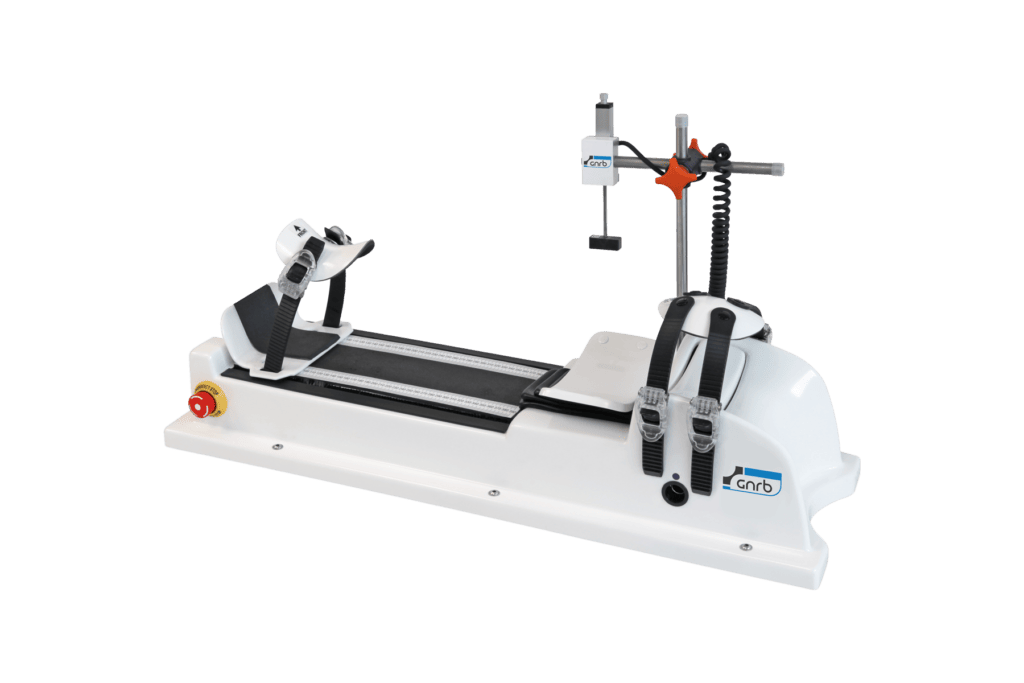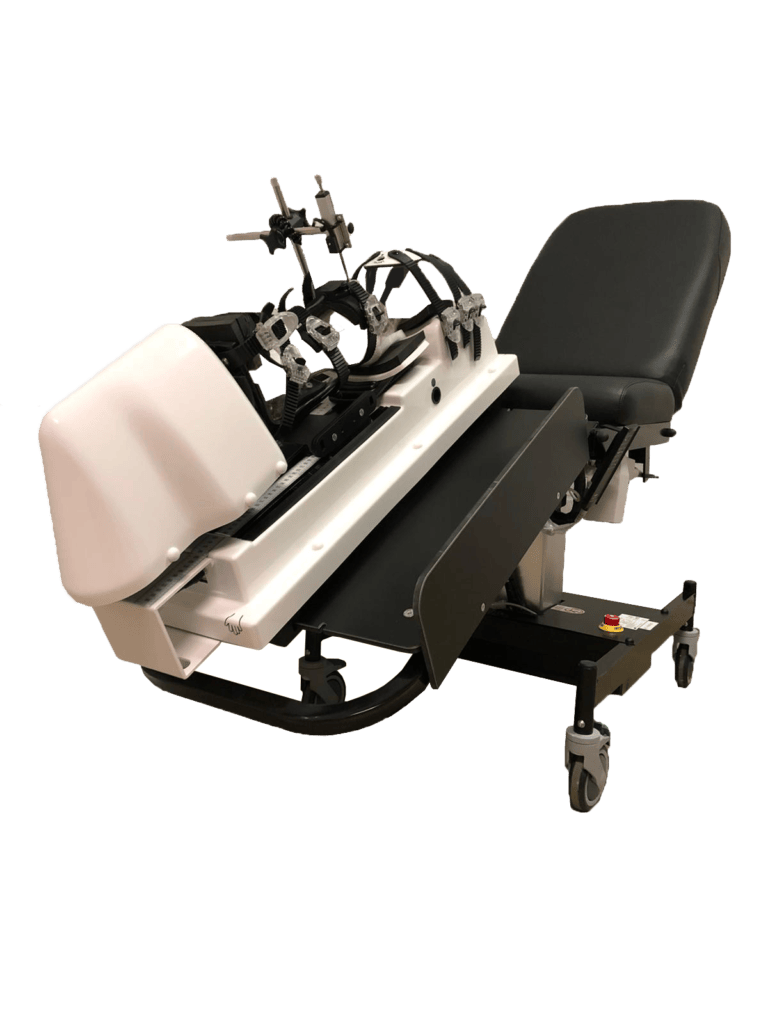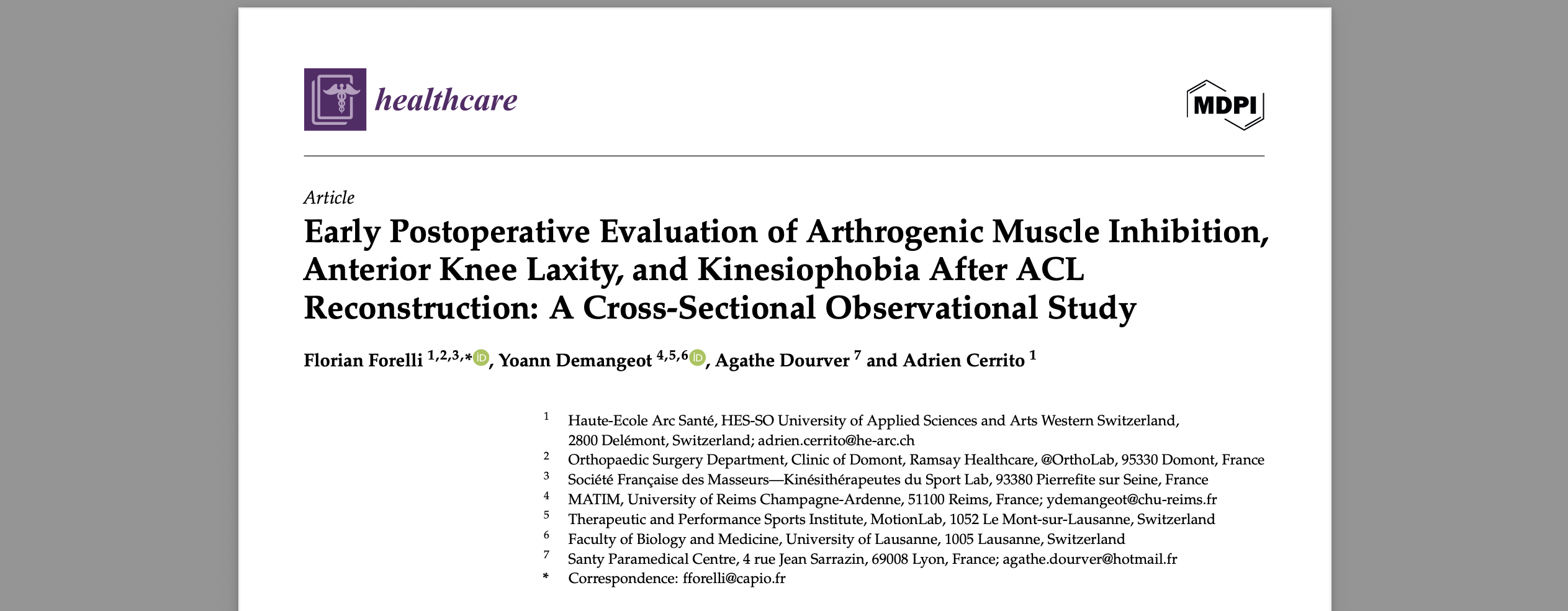The Emergence of New Arthrometers in Knee Stability Assessment
In the field of orthopaedics, particularly in sports medicine and joint reconstruction, the assessment of knee stability is crucial for diagnosing injuries and guiding treatment. One indispensable tool in evaluating the integrity of the anterior cruciate ligament (ACL) is the arthrometer, a device designed to objectively measure joint laxity and movement. Over the years, advancements in technology have refined the capabilities of these devices. The introduction of robotic / dynamic arthrometers, such as the DYNEELAX® and GNRB®, has set new standards in ACL diagnostics. These new arthrometers offer more precise measurements and comprehensive insights into knee stability.
This article will focus on the evolution of these new arthrometers, emphasizing their technological developments and the clinical benefits they offer, particularly the GNRB® and DYNEELAX®.
I. What is an Arthrometer?

An arthrometer is a medical device used to assess joint stability by measuring the degree of laxity or movement under controlled conditions. In orthopaedics, these devices are primarily used for evaluating the ACL, a crucial ligament that ensures knee stability. ACL injuries are common, especially among athletes, and arthrometers help clinicians quantify the extent of the injury and the degree of instability.
Historically, manual methods like the Lachman test or the pivot shift test were used to evaluate ACL integrity. However, these tests were subjective and dependent on the examiner’s experience. The introduction of arthrometers provided an objective, quantifiable measurement system, which was a significant improvement, offering more reliability in evaluating ACL injuries.
II. The Evolution of Arthrometers
Early arthrometers, such as the KT-1000 and KT-2000, were among the first devices used to measure anterior tibial translation, which is the primary movement indicating ACL insufficiency. However, these devices relied on manual force application, which introduced variability in results. New advancements, particularly robotic and dynamic arthrometers, provide greater precision and offer additional insights into knee biomechanics.
Do you want to buy a KT-1000 or KT-2000? Click here to see where to find it today !
2.1 The GNRB dynamic/ robotic Arthrometer
The GNRB® represents a significant leap forward in ACL diagnostics by incorporating robotic technology. Unlike its predecessors, the GNRB® applies controlled, automated translation forces to the tibia, measuring the displacement in relation to the femur. This robotic control eliminates the variability associated with manual force application, ensuring consistent and accurate results.
The GNRB® measures anterior tibial translation (ATT) with high precision, providing a detailed quantification of ACL laxity. Clinicians can apply forces at multiple levels (e.g., 134N, 150N, and 250N), allowing for the detection of both partial and complete ACL tears. The data provided by the GNRB® is essential for detecting subtle ACL deficiencies, enabling early diagnosis and intervention.
2.2 The Dyneelax dynamic/ robotic Arthrometer
While the GNRB® focuses on anterior translation, the Dyneelax goes further by assessing both translation and rotation, offering a more comprehensive evaluation of knee stability. This new arthrometer allows clinicians to analyze not only the anterior-posterior movement but also the rotational stability of the knee.
The DYNEELAX® integrates both robotic and dynamic components, measuring the knee’s rotational stability and offering insights into ACL function during movement. Rotational instability is a critical factor in ACL injuries, as the ligament helps prevent excessive rotation of the tibia relative to the femur. By capturing both translation and rotation data, the Dyneelax provides a holistic view of knee function, which is invaluable in diagnosing complex injuries.
Additionally, the DYNEELAX® performs these measurements dynamically, simulating real-life conditions like walking, running, or pivoting. This dynamic analysis gives clinicians a better understanding of how the knee behaves during movement, offering a more functional perspective of knee biomechanics.
III. Clinical Benefits of the New Arthrometers
The introduction of robotic and dynamic arthrometers like the DYNEELAX® and GNRB® has several clinical benefits, especially in the context of ACL injuries. These new devices offer significant improvements over traditional methods.
- Objective and Reproducible Measurements
One of the main challenges with manual knee stability tests is their subjectivity. Results can vary depending on the examiner’s skill and experience. New arthrometers provide objective, quantifiable data that eliminates this variability. The robotic force application ensures the same amount of force is applied consistently, leading to reproducible results that can be tracked over time.
- Enhanced Diagnostic Accuracy + Early Detection of Partial Tears
By measuring both translation and rotation, the DYNEELAX® offers a more complete understanding of knee stability. Many ACL injuries involve more than just anterior tibial translation; rotational instability is often a significant factor. Being able to assess both movements allows clinicians to diagnose complex injuries more accurately and plan appropriate treatments.
Detecting partial ACL tears can be challenging using traditional methods, as the ligament may still provide some degree of stability. Devices like the GNRB® are sensitive enough to detect subtle laxity that may not be evident during manual examination. Early detection is critical because it allows for timely intervention, potentially preventing a partial tear from progressing to a full rupture. A 2023 study conducted by Cojean demonstrated that arthrometers are more precise than MRI in diagnosing partial ruptures of the ACL, further highlighting their importance in early detection and accurate assessment.
- Dynamic, Functional Analysis
The DYNEELAX® stands out for its ability to simulate dynamic movements, such as those performed during sports. Traditional arthrometers usually measure knee laxity in static positions, which may not reflect how the knee behaves during movement. The dynamic analysis provided by the DYNEELAX® gives clinicians a more accurate representation of knee function during real-life activities, making it easier to understand the full impact of an ACL injury. Pairing these results with the results from MRI tests has been proven to refince overall treatment of patients suffering from ACL injuries.
-
Surgical Planning Using Translation + Rotation Dynamic Analysis
The ability of new arthrometers like the DYNEELAX® to measure both translation and rotation of the knee is invaluable for surgical planning in complex ACL injuries. A 2023 study by Cojean emphasized the importance of these dual measurements, showing that rotational laxity is often missed in standard tests that only assess translation. This can lead to incomplete diagnoses, particularly in cases where rotational instability plays a major role in knee dysfunction . Similarly, a 2024 study by Guegan et al. demonstrated how the DYNEELAX®‘s ability to simultaneously measure tibial translation and internal/external rotation aids surgeons in identifying all contributing factors to knee instability. The study, which involved 29 cadaveric knees, highlighted the critical role of medial structures such as the posterior horn of the medial meniscus (PHMM) and the medial collateral ligament (MCL) in controlling both anterior tibial translation and tibial rotation. These findings underscore the necessity of addressing both translational and rotational instability during ACL reconstruction surgeries to ensure complete joint stability.
-
Postoperative Monitoring of ACL Reconstruction
In addition to its role in surgical planning, the new arthrometer is a vital tool in postoperative monitoring, ensuring the ACL graft heals properly. According to a 2017 study by Nouveau, close monitoring of knee laxity post-surgery is critical to prevent graft failure and ensure the success of rehabilitation. The GNRB® and DYNEELAX® devices allow for objective measurement of knee stability over time, offering precise data on the healing process . Further supporting this, a 2023 study by Forelli et al. used arthrometers to determine return to sport in soccer players post-ACL reconstruction. Moreover, a 2019 Pouderoux study (2019) also concluded that a laximetry evaluation was needed before a return to sports. .
Conclusion
The development of new arthrometers, especially the GNRB® and DYNEELAX®, has transformed the assessment of knee stability. These devices offer objective, reproducible measurements and provide deeper insights into ACL injuries by incorporating both translation and rotation assessments. Their robotic and dynamic capabilities enable more precise diagnosis, early detection of partial tears, and comprehensive postoperative evaluation.
As technology continues to advance in orthopaedic diagnostics, new arthrometers like the GNRB® and DYNEELAX® are expected to become essential tools in the diagnosis and management of knee injuries. They empower clinicians to offer higher standards of care and ultimately improve patient outcomes.
Medical References
- Cojean, T. (2023). MRI vs. GNRB in ACL Injuries Detection: A Comparative Study. Journal of Orthopedic Research and Therapy (DOI: 10.1016/j.knee.2023.03.017).
- Cojean, T. (2023). Sensitivity, Repeatability, and Reproducibility Study with a Leg Prototype of a Recently Developed Knee Arthrometer Dyneelax. Journal of Biomechanics (DOI: 10.1016/j.medntd.2023.100254).
- Forelli (2023). After Surgery Rehab Post-Op. International Journal of Sports Physical Therapy. Submitted: October 10, 2022. Accepted: January 15, 2023. DOI: 10.26603/001c.73031.
- Pouderoux, T., Muller, B., Robert, H. (2019). Joint laxity and graft compliance increase during the first year following ACL reconstruction with short hamstring tendon grafts.. DOI: 10.1007/s00167-019-05711-z
- Nouveau, S., Robert, H., & Viel, T. (2017). ACL Grafts Compliance During Time: Influence of Early Solicitations on the Final Stiffness of the Graft after Surgery. Journal of Orthopedic Research and Physiotherapy (DOI: 10.24966/ORP-2052/100035).
- Guegan, B., Drouineau, M., Common, H., & Robert, H. (2024). All the menisco-ligamentary structures of the medial plane play a significant role in controlling anterior tibial translation and tibial rotation of the knee: Cadaveric study of 29 knees with the Dyneelax® laximeter. Journal of Experimental Orthopaedics, 11, e12038. DOI: 10.1002/jeo2.12038









